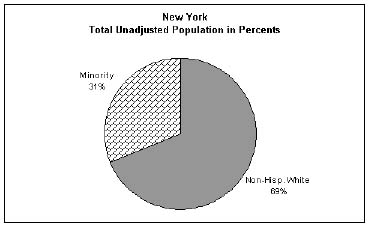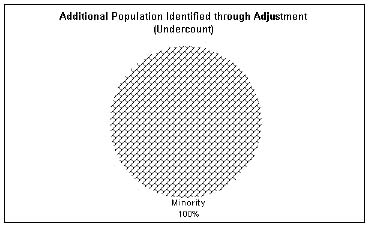State-by-State Analysis: New York
The
1990 undercount and its demographic composition
As
indicated in Table 1, the relative low overall undercount of 1.5 percent
in New York, slightly lower than the national average of 1.6 percent, conceals
an especially large undercount of minorities. New York is the only state
studied with an overcount of non-Hispanic whites, 50,604 persons, equal
to .4 percent of the state's uncorrected population of non-Hispanic whites.
In contrast, the state had a minority undercount of 5.8 percent, highest
among any of the states studied. Although the state's overall undercount
includes 272,036 persons, the undercount among minorities is a larger 322,640
persons. As indicated in Table 2 and the summary chart below, minorities
comprised 31 percent of the state's uncorrected population and 100 percent
of the state's undercounted population. In numerical terms, the undercount
consisted of 322,640 members of minority groups, primarily non-Hispanic
blacks and Hispanics. The New York undercount is third highest in the nation.
The
minority population of New York State is diverse. According to corrected
Census data, non-Hispanic blacks are 47 percent of New York's minority population,
Hispanics are 40 percent, and members of other minority groups are 13 percent.


Implications
of 1990 Census adjustment for minority voter opportunities
The
use of corrected data in New York for the post-1990 redistricting would
have had the potential to enhance minority voter opportunities in the plans
drawn for the State Senate and State Assembly. In the New York State Senate,
there are no districts with minority percentages approaching 50 percent.
However, the use of corrected data would have created the potential to enhance
minority voter opportunities by drawing districts in a way that increased
the minority percentage of State Senate District 14 in Queens County (40.5
percent minority). In Queens, correction uncovers some 49,000 additional
persons, all of them members of minority groups. These numbers are greater
than would have been necessary to meet one-person, one-vote requirements
given that the use of corrected rather than uncorrected data would increase
the population of an ideal Senate district from some 294,900 to 299,400
persons, a net increase of about 4,500 persons.
The
use of corrected rather than uncorrected Census data in New York would have
had the greatest potential impact on State Assembly districts. State Assembly
District 69, located in New York County (Manhattan), includes a minority
population of 48.4 percent. However, application of the corrected data for
1990 demonstrates that the population of this District is more accurately
measured at 50.0 percent. In addition, the use of corrected data in New
York County reveals a sufficient number of additional persons, most of them
minorities, so that if corrected rather than uncorrected data had been used
in the post-1990 redistricting, Assembly District 69 might have been drawn
to include a higher minority percentage than the current district, clearly
putting this district above the 50 percent mark. The use of corrected data
uncovers about an additional 54,000 persons in New York County, 97 percent
of them members of minority groups. These numbers are greater than would
have been necessary to meet one-person, one-vote requirements, given that
the use of corrected rather than uncorrected data would increase the population
of an ideal Assembly district from some 120,000 to 122,000 persons, a net
increase of about 2,000 persons.
The
use of corrected data would have created the potential to enhance minority
voter opportu nities by drawing districts in such a way as to increase the
minority percentage of several other State Assembly districts in the New
York City area. Also in New York County is Assembly District 63 with a minority
population of 41.5 percent. In Kings County are Assembly Districts 41 (42.7
percent), 46 (40.7 percent minority), and 50 (43.9 percent minority). The
use of corrected data uncovers about an additional 93,000 persons in Kings
County, all of them members of minority groups. These numbers are greater
than would have been necessary to meet one-person, one-vote requirements.
In Bronx County are Assembly Districts 80 (41.4 percent minority) and 81
(41.5 percent minority). The use of corrected data uncovers about an additional
64,000 persons in Bronx County, all of them members of minority groups.
These numbers are greater than would have been necessary to meet one-person,
one-vote requirements. In Queens County is Assembly District 30 (41.0 percent
minority). The use of corrected data uncovers about an additional 49,000
persons in Queens County, all of them members of minority groups. These
numbers are greater than would have been necessary to meet one-person, one-vote
requirements.





